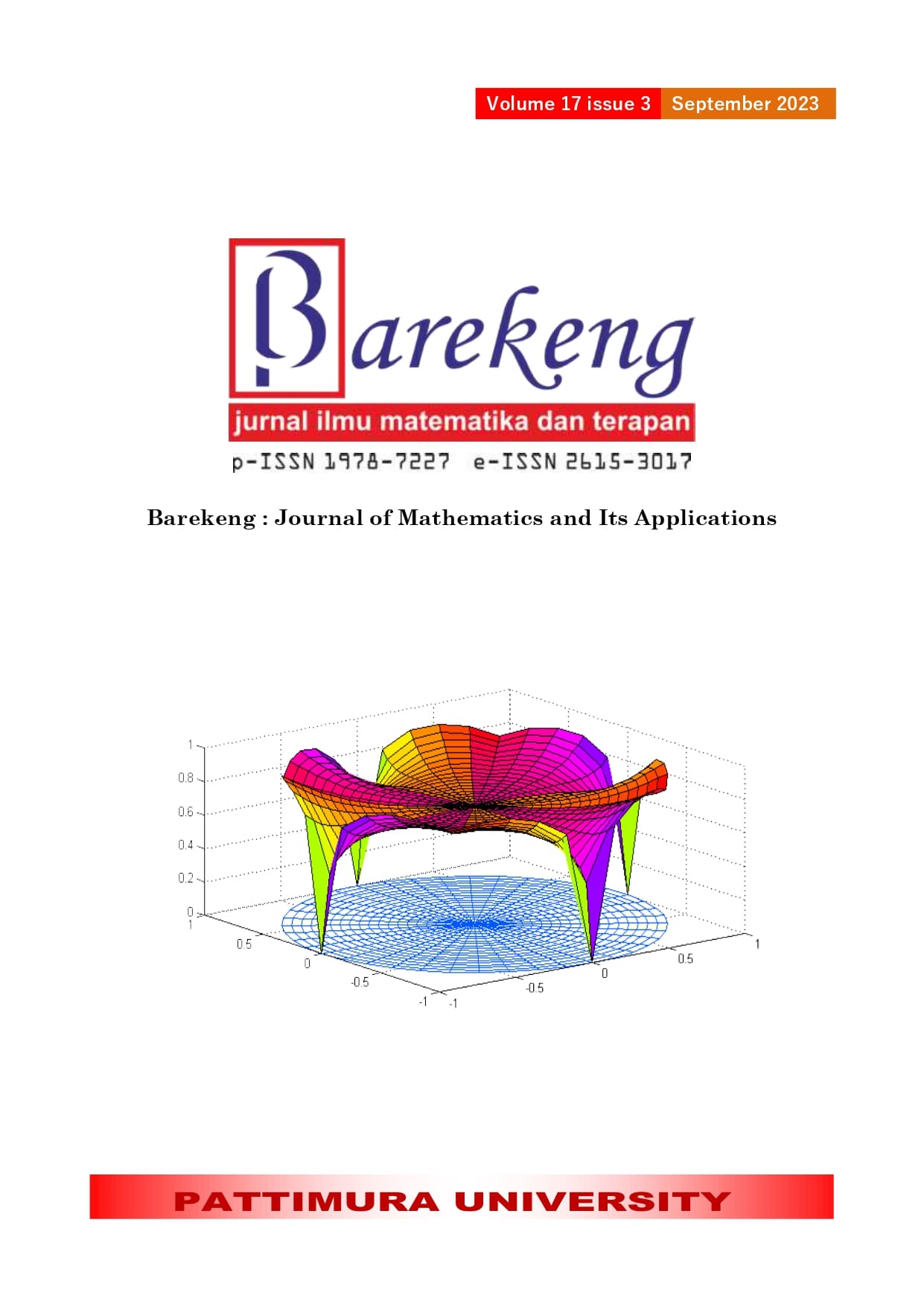A TWO-STEP CLUSTER FOR CLASSIFYING PROVINCES IN INDONESIA BASED ON ENVIRONMENTAL QUALITY
Abstract
The main objective of this study was to conduct a cluster analysis of the environmental health index in Indonesia for all the provinces. Clustering the environmental health index was important to reveal regional disparities, target and intervention policies, monitor progress over time, and allocate resources more effectively for improved environmental health outcomes. In this study, a sample of 34 units was utilized, encompassing all provinces in Indonesia. The environmental health index was clustered based on five indicators, namely Water Quality Index, Air Quality Index, Soil Quality Index, Marine Quality Index, and Land Cover Quality Index. This research used the two-stage clustering method, which was unique in combining both hierarchical and non-hierarchical clustering methods to produce a more accurate and reliable solution. Four clusters were determined to group provinces in Indonesia based on the environmental health index. The analysis found that the quality of clustering was in the fair but close to good category. The clustering results showed that 32% of the provinces were in cluster 4 and 26.5% of the provinces were in cluster 1. Then, 23.5% and 17.6% of the provinces were in clusters 2 and 3, respectively. In addition, two indicators were found to be the most predictive of the overall clustering solution, namely the Soil Quality Index and the Land Cover Quality Index. The results also implied that provinces in cluster 3 had the lowest environmental quality so they must improve it by looking at provinces in cluster 4, which was the group with the best environmental quality index.
Downloads
References
S. Nomani, M. Rasel, and I. K. Reedoy, “Industrial Development and Climate Change: A Case Study of Bangladesh,” Indones. J. Innov. Appl. Sci., vol. 2, no. 1, pp. 68–79, 2022, doi: https://doi.org/10.47540/ijias.v2i1.428.
S. Partelow and K. Nelson, “Social networks, collective action and the evolution of governance for sustainable tourism on the Gili Islands, Indonesia,” Mar. Policy, vol. 112, 2020, doi: https://doi.org/10.1016/j.marpol.2018.08.004.
J. Koehrsen, “Muslims and climate change: How Islam, Muslim organizations, and religious leaders influence climate change perceptions and mitigation activities,” Wiley Interdiscip. Rev. Clim. Chang., vol. 12, no. 3, p. e702, 2021, doi: https://doi.org/10.1002/wcc.702.
Ministry of Environment and Forestry, “Laporan Kinerja Lingkungan Hidup (Environmental Performance Report),” 2021.
T. R. N. Amanah, T. T. Putranto, and M. Helmi, “Application of cluster analysis and principal component analysis for assessment of groundwater quality—A study in Semarang, Central Java, Indonesia,” in IOP conference series: earth and environmental science, 2019, vol. 248, no. 1, p. 12063, doi: 10.1088/1755-1315/248/1/012063.
P. Luo et al., “Water quality trend assessment in Jakarta: A rapidly growing Asian megacity,” PLoS One, vol. 14, no. 7, p. e0219009, 2019, doi: https://doi.org/10.1371/journal.pone.0219009.
M. Benassi et al., “Using two-step cluster analysis and latent class cluster analysis to classify the cognitive heterogeneity of cross-diagnostic psychiatric inpatients,” Front. Psychol., vol. 11, p. 1085, 2020, doi: https://doi.org/10.3389/fpsyg.2020.01085.
V. Lytvynenko, I. Lurie, J. Krejci, M. Voronenko, N. Savina, and M. A. Taif, “Two Step Density-Based Object-Inductive Clustering Algorithm.,” in MoMLeT, 2019, pp. 117–135.
A. Iodice D’Enza and F. Palumbo, “Iterative factor clustering of binary data,” Comput. Stat., vol. 28, pp. 789–807, 2013, doi: https://doi.org/10.1007/s00180-012-0329-x.
M. Van de Velden, A. Iodice D’Enza, and A. Markos, “Distance‐based clustering of mixed data,” Wiley Interdiscip. Rev. Comput. Stat., vol. 11, no. 3, p. e1456, 2019, doi: https://doi.org/10.1002/wics.1456.
A. Supandi, A. Saefuddin, and I. D. Sulvianti, “Two step cluster application to classify villages in Kabupaten Madiun based on village potential data,” Xplore J. Stat., vol. 10, no. 1, pp. 12–26, 2021.
T. Chiu, D. Fang, J. Chen, Y. Wang, and C. Jeris, “A robust and scalable clustering algorithm for mixed type attributes in large database environment,” in Proceedings of the seventh ACM SIGKDD international conference on knowledge discovery and data mining, 2001, pp. 263–268, doi: https://doi.org/10.1145/502512.502549.
I. N. Martínez, J. M. Morán, and F. J. Peña, “Two‐step cluster procedure after principal component analysis identifies sperm subpopulations in canine ejaculates and its relation to cryoresistance,” J. Androl., vol. 27, no. 4, pp. 596–603, 2006, doi: https://doi.org/10.2164/jandrol.05153.
R. Haines-Young and M. Potschin, “The links between biodiversity, ecosystem services and human well-being,” Ecosyst. Ecol. a new Synth., vol. 1, pp. 110–139, 2010.
J. B. Kowalska, R. Mazurek, M. Gąsiorek, and T. Zaleski, “Pollution indices as useful tools for the comprehensive evaluation of the degree of soil contamination–A review,” Environ. Geochem. Health, vol. 40, pp. 2395–2420, 2018, doi: https://doi.org/10.1007/s10653-018-0106-z.
A. Tkaczynski, “Segmentation using two-step cluster analysis,” in Segmentation in social marketing, Springer, 2017, pp. 109–125.
Copyright (c) 2023 Umi Mahmudah, Muhamad Safiih Lola

This work is licensed under a Creative Commons Attribution-ShareAlike 4.0 International License.
Authors who publish with this Journal agree to the following terms:
- Author retain copyright and grant the journal right of first publication with the work simultaneously licensed under a creative commons attribution license that allow others to share the work within an acknowledgement of the work’s authorship and initial publication of this journal.
- Authors are able to enter into separate, additional contractual arrangement for the non-exclusive distribution of the journal’s published version of the work (e.g. acknowledgement of its initial publication in this journal).
- Authors are permitted and encouraged to post their work online (e.g. in institutional repositories or on their websites) prior to and during the submission process, as it can lead to productive exchanges, as well as earlier and greater citation of published works.






1.gif)



